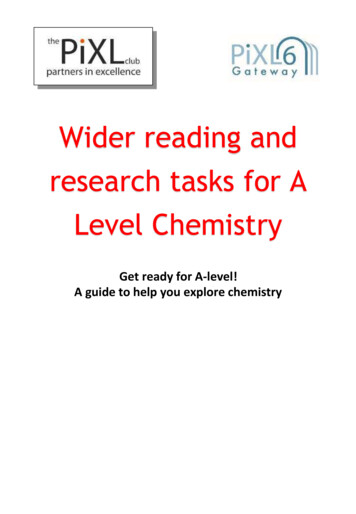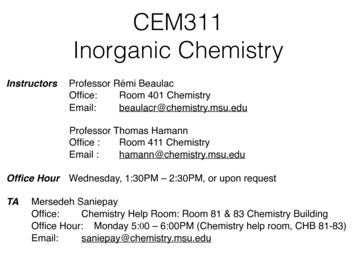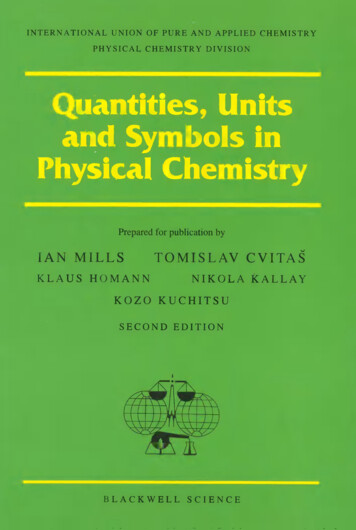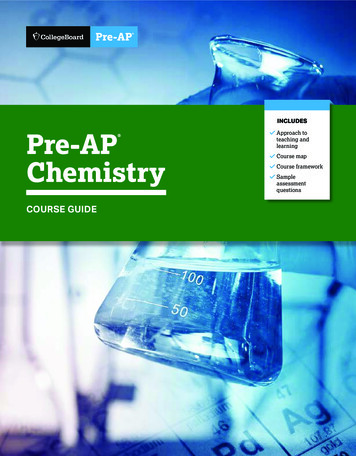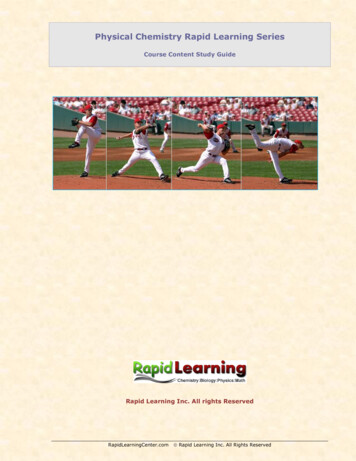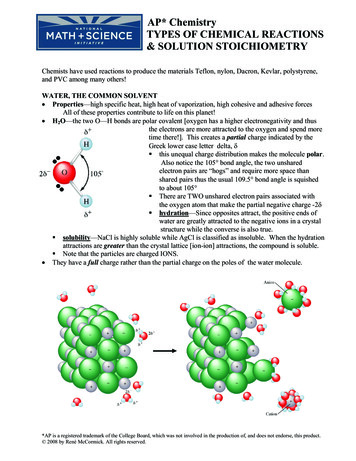
Transcription
AP* ChemistryTYPES OF CHEMICAL REACTIONS& SOLUTION STOICHIOMETRYChemists have used reactions to produce the materials Teflon, nylon, Dacron, Kevlar, polystyrene,and PVC among many others!WATER, THE COMMON SOLVENT Properties—high specific heat, high heat of vaporization, high cohesive and adhesive forcesAll of these properties contribute to life on this planet! H2O—the two O—H bonds are polar covalent [oxygen has a higher electronegativity and thusthe electrons are more attracted to the oxygen and spend moretime there!]. This creates a partial charge indicated by theGreek lower case letter delta, δ this unequal charge distribution makes the molecule polar.Also notice the 105 bond angle, the two unsharedelectron pairs are “hogs” and require more space thanshared pairs thus the usual 109.5 bond angle is squishedto about 105 There are TWO unshared electron pairs associated withthe oxygen atom that make the partial negative charge -2δ hydration—Since opposites attract, the positive ends ofwater are greatly attracted to the negative ions in a crystalstructure while the converse is also true. solubility—NaCl is highly soluble while AgCl is classified as insoluble. When the hydrationattractions are greater than the crystal lattice [ion-ion] attractions, the compound is soluble. Note that the particles are charged IONS. They have a full charge rather than the partial charge on the poles of the water molecule.*AP is a registered trademark of the College Board, which was not involved in the production of, and does not endorse, this product. 2008 by René McCormick. All rights reserved.
Water can also dissolve nonionic substances such as alcohols and sugars among others.Alcohols and sugars contain O—H bonds that are polar just as the O—H bond in water. Thispolarity makes the molecule soluble.hydration inaction!ethanolethanol attracted to water Fats do not dissolve in water since they are nonpolar. “Like dissolves like” isa useful guideline for predicting solubility.THE NATURE OF AQUEOUS SOLUTIONS: STRONG AND WEAK ELECTROLYTESRemember a solution is a homogeneous mixture where a solute is dissolved in a solvent. Aqueoussolutions are solutions where the solvent is water.Properties of Aqueous Solutions electrolytes--solutions that conduct an electric current strong Λ completely dissociate (consult solubility rules—strong acids, strong bases andsoluble salts) Barium chloride is an ionic salt thatcompletely ionizes in water, HCl is a strong acid that completely dissociates into ions inwater while NaOH is a strong base that completely dissociates in water. All 3 releasecharged particles that readily conduct electricity.COMMON Strong acids: HCl, HBr, HI, HNO3, H2SO4 [loses first H easily and existsmainly as H and HSO4- ions in water] AND HClO4COMMON Strong bases: Oxides and Hydroxides of I & II A metals [solubility issues withthe IIA’s]2Types of Reactions & Solution Stoichiometry
weak ) do not completely dissociate; only about 1% dissociation(weak acids and bases; ammonia, acetic acid)nonelectrolytes--solutions where dissolving has occurred but the solutedoes not make ions and therefore cannot conduct electricity. (Pure water,sugar, alcohols, antifreeze, and starch) Arrhenius was the first to identify the conductive properties of solutions in the late 1890’s he correctly postulated that the extent to which a solution can conduct an electric currentdepends directly on the number of ions present.THE COMPOSITION OF SOLUTIONSChemical reactions often take place when two solutions are mixed. To perform stoichiometriccalculations in such cases two things must be known: (1) The nature of the reaction which dependson the exact whether or not the substance exists as ions or molecules in solution AND (2) theamount of chemicals present in the solution.moles of soluteMolarity [M ] moles of solution Molarity--concentration unit of moles per liter. [NaCl] 0.75 M means 0.75 moles of salt iscontained in 1.00 L of solution. The square brackets indicate whatever is inside is a) insolution and b) its concentration is expressed in molarity.gM FWLiters of solutionPreparing Solutions of KNOWN concentrationWeigh out the solid as accurately as possible, place in a volumetric flask, add enoughdistilled water to dissolve the solid THEN add water, filling to the mark on the flask. If youdump solid into 1.00 L of water you are neglecting the space the solid will occupy and yoursol’n will NOT be correct.3Types of Reactions & Solution Stoichiometry
Exercise 1Calculate the molarity of a solution prepared by dissolving 11.5 g of solid NaOH in enough water tomake 1.50 L of solution.0.192 M NaOHExercise 2Calculate the molarity of a solution prepared by dissolving 1.56 g or gaseous HC1 in enough waterto make 26.8 mL of solution.1.60 M HC1 Multiply the ions by their subscript if asked how many are present in a blah blah M sol’n ofthe whole cmpd.Exercise 3Give the concentration of each type of ion in the following solutionsa. 0.50 M Co(NO3)2b. 1 M Fe(C1O4)3a. 0.50 M Co2 and (2 x 0.50) M NO3- or 1.0 M NO3b. 1 M Fe3 ions and 3 M C1O4- ionsALWAYS REMEMBER AND NEVER EVER FORGET . . .Concentration (M) Volume (in liters) molesNumber of moles M L of solution4Types of Reactions & Solution Stoichiometry
Exercise 4Calculate the number of moles of C1 ions in 1.75 L of 1.0 10-3 M ZnC12.3.5 10-3 mol C1-Exercise 5Typical blood serum is about 0.14 M NaC1. What volume of blood contains 1.0 mg NaC1?0.12 mL of blood contains 1.7 10-5 mol NaC1 or 1.0 mg NaC1 Standard solution—is a solution whose concentration is accurately known volumetric flask—contains an exact total volume of solutionSteps involved in the preparation of a standard solution. a) A weighed amount of a substance (the solute)is put into the volumetric flask, and a small quantity of water is added. (b) The solid is dissolved in thewater by gently swirling the flask (with the stopper in place). (c) More water is added, until the level ofthe solution just reaches the mark etched on the neck of the flask (d).5Types of Reactions & Solution Stoichiometry
Exercise 6To analyze the alcohol content of a certain wine, a chemist needs 1.00 L of an aqueous 0.200 MK2Cr2O7 (potassium dichromate) solution. How much solid K2Cr2O7 must be weighed out to makethis solution ? [FYI—this was initially the “stuff” used for breathalyzers!]58.8 g K2Cr2O7DILUTION M 1V1 M 2V2Preparing solutions by dilution. Often your sol n involves diluting a more concentratedsoln . (most common with acids). The more concentrated solution is the stock solution. pipet—a device for accurately measuring and transferring a givenvolume of solution measuring pipet (a)—used to measure volumes for which avolumetric pipet is not available—has gradations volumetric or transfer pipet (b)—gives only one measurement 5mL,10mL, etc.Generally, you would measure out the quantity of stock solution youdetermined from the dilution formula given above, and place it in avolumetric flask that would contain the volume of the diluted solution youneeded to prepare. Next, you would fill the volumetric to the mark on theneck with deionized or distilled water until the meniscus reached the mark.6Types of Reactions & Solution Stoichiometry
Exercise 7What volume of 16 M sulfuric acid must be used to prepare 1.5 L of a 0.10 M H2SO4 solution ?9.4 mL of acidTYPES OF CHEMICAL REACTIONSCHEMICAL EQUATIONS chemical reaction--transforms elements and compounds into new substances balanced chemical equation--shows the relative amounts of reactants and products s, l, g, aq--solid, liquid, gas, aqueous solution NO ENERGY or TIME is alluded to Antoine Lavoisier (1743-1794)--law of conservation of matter: matter can neither be creatednor destroyed ) this means “balancing equations” is all his fault!!Not all reactions will fall neatly into just one category, but we have to start somewhere!We will be starting AP Net Ionic Equations very soon where you will see several categoriesinvolved.PRECIPITATION REACTIONSThe formation of a precipitate is a driving force for a chemical reaction. A precipitate is aninsoluble solid that is formed when two aqueous solutions are mixed. We often separate theprecipitate (ppt) from solution by filtration in what is called a gravimetric analysis.To identify the precipitate, you MUST know your solubility rules—expect quizzes on thesethroughout the year!7Types of Reactions & Solution Stoichiometry
SOLUBILITY RULES: memorize!!!Most alkali metal salts AND NH4 salts ARE solubleHeavy metalCl-, Br-, I- are soluble, *except for Ag , Hg2 2, Pb 2BAD GUYS!F are soluble, *except for IIA metalsNO3-, ClO3-, ClO4-, and CH3COO- are solubleSO4-2 are soluble, *except for Ca2 , Sr 2, Ba 2, Ag , Pb 2, Hg22 CO3-2, PO4-3, C2O4-2, CrO4-2, S-2, OH-, and O-2 are INSOLUBLE(rule 1 takes priority!)It can be assumed that ionic cmpds. that dissolve in water are strongelectrolytes and are therefore soluble.1.2.3.4.5.6.Exercise 8Using the solubility rules, predict what will happen when the following pairs of solutions are mixed.a. KNO3(aq) and BaC12(aq)b. Na2SO4(aq) and Pb(NO3)2(aq)c. KOH (aq) and Fe(NO3)3(aq)a. All the ions remain dissolved in solution.No chemical reaction occurs.b. The compound NaNO3 is soluble, butPbSO4 is insoluble. Mixed, PbSO4 willprecipitate from the solution.c. K and NO3- salts are soluble. Fe(OH)3 isslightly soluble and will precipitate.DESCRIBING REACTIONS IN SOLUTIONThree ways:1. COMPLETE balanced equation—gives the overall reaction stoichiometry, but NOT theforms of the reactants & products as they exist in solution [the way we taught you in firstyear chem.]2. complete ionic equation—represents as IONS all reactants & products that are strongelectrolytes3. net ionic equations—includes only those solution components undergoing a change.Spectator ions are NOT included spectator ions--not involved in the reaction process Λ started as an ion AND finished as anion THERE IS ALWAYS A CONSERVATION OF CHARGE IN NET IONIC EQN’S.8Types of Reactions & Solution Stoichiometry
Exercise 9For each of the following reactions, write the molecular equation, the complete ionic equation, andthe net ionic equation.a. Aqueous potassium chloride is added to aqueous silver nitrate to form a silver chlorideprecipitate plus aqueous potassium nitrate.b. Aqueous potassium hydroxide is mixed with aqueous iron(III) nitrate to form aprecipitate of iron(III) hydroxide and aqueous potassium nitrate.Answers:a. Molecular Equation:KCI(aq) AgNO3(aq) AgC1(s) KNO3(aq)Complete Ionic Equation:K (aq) C1-(aq) NO3-(aq) AgC1(s) K (aq) NO3-(aq)Net Ionic Equation:C1-(aq) Ag (aq) AgC1(s)b. Molecular Equation:3KOH(aq) Fe(NO3)3(aq) Fe(OH)3(s) 3KNO3(aq)Complete Ionic Equation:3K (aq) 3OH-(aq) Fe3 (aq) 3NO3-(aq) Fe(OH)3(s) 3K (aq) 3NO3-(aq)Net Ionic Equation:3OH-(aq) Fe3 (aq) Fe(OH)3(s) Chemical analysis of mixtures by PRECIPITATION REACTIONSform an insoluble salt, filter the salt out and then dry to constant mass.use stoichiometry to determine the desired quantity.Exercise 10Calculate the mass of solid NaC1 that must be added to 1.50 L of a 0.100 M AgNO3 solution toprecipitate all the Ag ions in the form of AgC1.8.77 g NaC19Types of Reactions & Solution Stoichiometry
Exercise 11When aqueous solutions of Na2SO4 and Pb(NO3)2 are mixed, PbSO4 precipitates. Calculate the massof PbSO4 formed when 1.25 L of 0.0500 M Pb(NO3)2 and 2.00 L of 0.0250 M Na2SO4 are mixed.15.2 g PbSO4ACIDS-BASES REACTIONS acids--any cmpd. that, on reaction with water, produces an ion called the hydronium ion, H3O [or H ], and an anion (Arrhenius definition) base--any cmpd. that provides a hydroxide, OH ,and a cation in water (Arrhenius definition)**ammonia, NH3 is an exception, so Bronsted-Lowry defined it as a proton acceptor!! neutralization—when moles acid moles base each is neutralized [pH is not necessarily 7.0].The products formed are a salt [ask yourself if it is soluble] and waterExercise 12What volume of a 0.100 M HC1 solution is needed to neutralize 25.0 mL of 0.350 M NaOH ?8.75 x10-2 L (87.5 mL)10Types of Reactions & Solution Stoichiometry
A chance to practice limiting reactant!Exercise 13In a certain experiment, 28.0 mL of 0.250 M HNO3 and 53.0 mL of 0.320 M KOH are mixed.Calculate the amount of water formed in the resulting reaction. What is the concentration of H orOH ions in excess after the reaction goes to completion?0.123 M OH- Acid-Base Titrationso Volumetric analysis—a technique for determining the amount of a certain substance bydoing a titrationo titrant—the substance delivered from a buret so that its volume is accurately knowno analyte—the substance being analyzed; its mass or volume must also be accurately knowno More terms to know:equivalence point--# moles of OH equals (is equivalent to) # moles of H3O [acid-base titration; redox titrations also exist!]indicator--undergoes a color change near the equivalence point.standardization--a procedure for establishing the exact concentration of areagent11Types of Reactions & Solution Stoichiometry
Exercise 14A student carries out an experiment to standardize (determine the exact concentration of) a sodiumhydroxide solution. To do this the student weighs out a 1.3009-g sample of potassium hydrogenphthalate (KHC8H4O4, often abbreviated KHP). KHP (molar mass 204.22 g/mol) has one acidichydrogen. The student dissolves the KHP in distilled water, adds phenolphthalein as an indicator, andtitrates the resulting solution with the sodium hydroxide solution to the phenolphthalein endpoint.The difference between the final and initial buret readings indicates that 41.20 mL of the sodiumhydroxide solution is required to react exactly with the 1.3009 g KHP. Calculate the concentration ofthe sodium hydroxide solution.0.1546 MExercise 15An environmental chemist analyzed the effluent (the released waste material) from an industrialprocess known to produce the compounds carbon tetrachloride (CC14) and benzoic acid (HC7H5O2), aweak acid that has one acidic hydrogen atom per molecule. A sample of this effluent weighing 0.3518g was shaken with water, and the resulting aqueous solution required 10.59 mL of 0.1546 M NaOHfor neutralization. Calculate the mass percent of HC7H5O2 in the original sample.56.82%12Types of Reactions & Solution Stoichiometry
OXIDATION-REDUCTION REACTIONS involve electron transferTerms to Know:OIL RIG – oxidation is loss, reduction is gain (of electrons)Oxidation – the loss of electrons, increase in chargeReduction – the gain of electrons, reduction of chargeOxidation number – the assigned charge on an atomOxidizing agent (OA) – the species that is reduced and thus causes oxidationReducing agent (RA) – the species that is oxidized and thus causes reductionRules for Assigning Oxidation States—you know most of this already!1. The oxidation state of an atom in an element is ZERO including allotropes [i.e. N2, P4, S8].2. The oxidation state of a monatomic ion is the same as its charge.3. In its compounds, fluorine is always assigned an oxidation state of -1.4. Oxygen is usually assigned an oxidation state of -2 in its covalent compounds, suchas CO, CO2, SO2, and SO3. Exceptions to this rule include peroxides (compoundscontaining the O22- group), where each oxygen is assigned an oxidation state of -1,as in hydrogen peroxide (H2O2), and OF2 in which oxygen is assigned a 2oxidation state.5. In its covalent compounds with nonmetals, hydrogen is assigned an oxidation stateof 1. Metal hydrides are an exception; H is at the end of the chemical formula since ithas an oxidation state of 1-.6. The sum of the oxidation states must be zero for an electrically neutral compound.For a polyatomic ion, the sum of the oxidation states must equal the charge of the ion.Exercise 16Assign oxidation states to all atoms in the following.a. CO2b. SF6c. NO3 a. oxygen is -2 & carbon is 4b. fluorine is -6 & sulfer is 6c. oxygen is -6 & nitrogen is 5There can be non-integer oxidation states like in Fe3O4. There’s a -8 for the 4 oxygens divided across3 iron ions, therefore Fe’s charge is Fe8/3 13Types of Reactions & Solution Stoichiometry
Exercise 17When powdered aluminum metal is mixed with pulverized iodine crystals and a drop of water isadded to help the reaction get started, the resulting reaction produces a great deal of energy. Themixture bursts into flames, and a purple smoke of I2 vapor is produced from the excess iodine. Theequation for the reaction is2A1(s) 3I2(s) 2A1I3(s)For this reaction, identify the atoms that are oxidized and reduced, and specify the oxidizing andreducing agents.Aluminum is oxidized; Iodine is reducedA1 is the reducing agent; I2 is the oxidizing agentExercise 18Metallurgy, the process of producing a metal from its ore, always involves oxidation-reductionreactions. In the metallurgy of galena (PbS), the principal lead-containing ore, the first step is theconversion of lead sulfide to its oxide (a process called roasting):2PbS(s) 3O2(g) 2PbO(s) 2SO2(g)The oxide is then treated with carbon monoxide to produce the free metal:PbO(s) CO(g) Pb(s) CO2(g)For each reaction, identify the atoms that are oxidized and reduced, and specify the oxidizing andreducing agents.First Reaction:sulfur is oxidized; oxygen is reducedO2 is the oxidizing agent; PbS is the reducing agentSecond Reaction:carbon is oxidized; lead is reducedPbO is the oxidizing agent; CO is the reducing agent14Types of Reactions & Solution Stoichiometry
Balancing Redox Reactions by Half Reaction Method1. Divide the equation into oxidation and reduction half reactions. [OILRIG]2. Balance all elements besides hydrogen and oxygen.3. Balance O’s by adding H2O’s to the appropriate side of each equation.4. Balance H’s by adding H 5. Balance the charge by adding electrons. [OILRIG again]6. Multiply the half reactions to make electrons equal for both half-reactions.7. Cancel out any common terms and recombine the two half reactions.8. IF BASIC, neutralize any H by adding the SAME NUMBER of OH- to EACH side of thebalanced equation. [This creates some waters that will cancel!]9. CHECK!!Sample Problem: Assign oxidation states to all atoms in the following equation, identify the oxidationand reduction half reactions, and the OA and RA.MnO4 (aq) Fe2 (aq) Æ Mn 2(aq) Fe3 (aq)Sample Problem: Balance the following equation using the half-reaction method.(acidic) MnO4 (aq) I (aq) Æ Mn 2(aq) I2(aq)(basic) Ag(s) CN O2 Æ Ag(CN)2 (aq)15Types of Reactions & Solution Stoichiometry
Exercise 19Potassium dichromate (K2Cr2O7) is a bright orange compound that can be reduced to a blue-violetsolution of Cr3 ions. Under certain conditions, K2Cr2O7 reacts with ethyl alcohol (C2H5OH) asfollows:H (aq) Cr2O72 (aq) C2H5OH(l) Cr3 (aq) CO2(g) H2O(l)Balance this equation using the half-reaction method.Elements balance: 22H, 4Cr, 15O, 2C 22H, 4Cr, 15O, 2CCharges balance: 16 2(-2) 0 12 4( 3) 0 0 12Exercise 20Silver is sometimes found in nature as large nuggets; more often it is found mixed with other metalsand their ores. An aqueous solution containing cyanide ion is often used to extract the silver using thefollowing reaction that occurs in basic solution:Ag(s) CN (aq) O2(g) Ag(CN)2 (aq)Balance this equation using the half-reaction method.Elements balance: 8C, 8N, 4Ag, 4O, 4H 8C, 8N, 4Ag, 4O, 4HCharges balance: 8(1-) 0 0 0 8- 4(1-) 4(1-) 816Types of Reactions & Solution Stoichiometry
P B.1 (pg 1 of 5)Solution StoichiometryNameWrite out a balanced equation that represents the combination of the following aqueous salt, and then complete the stoichiometryproblem. Write both the molecular equation and the net ionic equation.1.2.3.4.If 25.0 ml of a 0.34 M solution of lead(II) nitrate is combined with 25.0 ml of 0.34 M sodium iodide solution (Assumevolumes are additive.),a.calculate the mass of the precipitate that should form.b.If 1.50 g of precipitate did form in the laboratory, calculate the % yield.c.Determine the concentration (molarity) of each ion still floating in the solution.Assume the reaction goes to completion, and the volumes are additive, when 45.0 ml of a 0.54 M solution of barium nitrate iscombined with 35.0 ml of 0.54 M sodium phosphate solution,a.calculate the mass of the precipitate that should form.b.If 3.32 g of precipitate did form in the laboratory, calculate the % yield.c.Determine the concentration (molarity) of each ion still floating in the solution.Assume the reaction goes to completion, and the volumes are additive, when 40.0 ml of 0.87 M solution of silver nitrate iscombined with 55.0 ml of 0.57 M of potassium chromate.a.calculate the mass of precipitate that should form.b.If 4.96 g of the precipitate forms in the laboratory, calculate the % yield of ppt formed.c.Determine the concentration (molarity) of each ion still floating in the solution.Assume the reaction goes to completion, and the volumes are additive, when 35.0 ml of 0.25 M tin(II) nitrate is combinedwith 45.0 ml of 0.30 M potassium phosphate.a.calculate the mass of precipitate that should form.b.In the lab, the precipitate was washed, dried and massed as 1.00 g, calculate the % yield of ppt formed.c.Determine the concentration (molarity) of each ion still floating in the solution.5.An excess of cobalt (II) chloride is combined with 35.0 ml of a potassium carbonate solution. Assuming that the reaction goesto completion and 8.11 g of the dried precipitate forms, determine the original molarity of the potassium carbonate solution.6.An excess of 15.0 ml of potassium chromate is combined with an excess of a aluminum chloride solution. Assuming that thereaction goes to completion and 1.54 g of the dried precipitate forms, determine the original molarity of the potassiumchromate solution.7.A volume of 0.50 M cobalt (II) chloride is combined with an excess of potassium ferrocyanide solution. Assuming that thereaction goes to completion and 4.37 g of the dried precipitate forms, determine the original volume of the cobalt (II) chloridesolution. (NOTE: ferrocyanide ion is Fe(CN)64 )8.When 0.64 M solution of copper (II) sulfate solution is combined with an excess of potassium chromate, and 12.3 g of thedried precipitate forms, determine the original volume of the copper (II) sulfate solution used.9.When an excess of cobalt (II) chloride is combined with a 0.35 M solution of potassium chromate, and 3.86 g of the driedprecipitate forms, determine the original volume of the potassium chromate solution used.
P A.2 (pg 1 of 3)Oxidation NumbersName PerIn first year chemistry you learned a quick method of determining whether a reaction is an oxidation reduction reaction. Thatquick method was to look for any “lone” elements in the reaction, such as in single replacement reactions. You may recall theequation below from lab work.2 AgNO3 Cu 2 Ag Cu(NO3)2In fact, all single replacement reactions are redox reactions. You may also recall that combustion reactions are also alwaysredox reactions. Recall the combustion of methane (from the Bunsen burner) shown below.CH4 2 O2 CO2 2 H2OYou learned that double replacement reactions, precipitation-type or acid base-type are never redox reactions.In this AP chemistry course, we will push further in to other types of reactions that do not necessarily involve “lone”elements, but will be a redox reaction. We need a method to identify these reactions and we need a method to track theelectrons lost and gained during the reaction. Tracking electrons will help identify the oxidizing agent the species whichcauses oxidation and gets reduced itself. Likewise, tracking the electrons will also identify the reducing agent the specieswhich causes reduction and gets oxidized itself.Chemists have devised a scheme for tracking electrons, which is like bookkeeping for electrons each shared electron isassigned to the atom which attracts the electrons most strongly. Then a number, called the oxidation state or oxidationnumber, is given to each atom based on the electron assignments. In other words, the oxidation number is the charge that anatom would have if electrons were transferred completely, not shared. Tracking electrons will provide a tool to help balancechallenging equations as well as providing the total number of electrons transferred the same amount is always lost as isgained. This quantity of electrons transferred is useful in thermochemical and electrochemical calculations.So be able to use oxidation numbers, you need to follow some rules to assign them. The following rules are hierarchical.That is to say, if any two rules conflict, follow the rule that is higher on the list.1 The oxidation state of an atom in its elemental form is 0.such as Cu, He, O2, or P4 , etc.2 The oxidation state of a monoatomic ion is equal to its charge.such as Ca2 , Cl , etc.3 The sum of the oxidation states of all atoms in: A neutral molecule or formula unit is 0 An ion is equal to the charge of the ion.This rule must always be followed.H2O (2 ox state of H) (ox state of O) 0NO3 (ox state of N) (3 ox state of O) 14 In ionic compounds, metals always have positive oxidation states. Group 1A metals are always 1 Group 2A metals are always 2KClK 1MgBr2 Mg 25 In ionic or molecular compounds, nonmetals are assigned oxidationstates as listed below (This too is a hierarchical list): Fluorine 1MgF2F 1 Hydrogen 1H 2Oeach H 1 Oxygen 2CO2each O 2 Group 7A 1CCl4each Cl 1 Group 6A 2H2SS 2 Group 5A 3NH3N 3Practice1.2.Give the oxidation number of the carbon in each ofthe following compounds:a. CF2Cl2b. Na2C2O4c. HCO3 d. C2H6e. CH2OGive the oxidation number of the bromine in each ofthe following compounds:a. KBrb. BrF3c. HBrO3d. CBr43.Give the oxidation number of the nitrogen in each ofthe following compounds:a. NO3 b. N2F4c. NH4 d. HNO2e. N24.Give the oxidation number of the sulfur in each ofthe following compounds:a. SOCl2b. H2Sc. H2SO3d. SO42 e. S8
P B.2Balancing Redox Equations(pg 1 of 2)Using whichever method works best for you, balance the following oxidation/reduction reactions.1.2.Balance the following net ionic Redox reactions in acidic solution:Mn2 Cl! "a.MnO4! b.Cu SO42!c.Pb d.MnO2 e.Br2 SO2 "f.P4(s) NO3!g.Cr2O72!h.NO3!i.CuS j.H2S SO2(g)"SO42!PbO2 Br!CH3OH Fe"NO3!SO42!" Cr3 "FeSNO(g) CH2ONH4 Cu2 "Fe3 Pb2 Fe2 Cu2 PbSO4"H3PO4(aq)"Cl2 PbO2 " MnO4! S(s) NO(g)S(s)Balance the following net ionic Redox reactions in basic solution:a.MnO4!b.Bi(OH)3c.MnO4!d.Pb2 e.Bi(OH)2f.Zng.Alh.H 2O 2i.O3BrO3! " MnO2 OCl! Bi(s)"C2O42! SnO22!Bi"NO3!" NH3(aq)OH-1" Al(OH)4!I!"IO3!Br!"O2CO32! Cl!PbO2Sn(OH)3!SnO32! MnO2""BrO4! Sn(OH)62! Zn(OH)42! H2H 2OBrO3!
Unit C: Free Response QuestionsThe following free responses are taken DIRECTLY from released AP exams, the rubrics can be found at the end of thispacket. Try these and see how many points you can get on your own. Each should take you under 15 mins197119751977
19781980
19851989
Don’t look back here till you’ve tied the worksheets on your own
P B.1 (pg 2 of 5)1.ANSWERSSolution Stoichiometrymolecular:Pb(NO3)2 net ionicPb2 2 I 2 NaIPbI2 (ppt) P B.1 (pg 3 of 5)2 NaNO3c.first, realize that we will assume there will be no barium ions left in solution since they are the limiting reactant.PbI2 (ppt)First, be sure you are working in moles change both reactants to mole quantitiesThen determine the amount of spectator ions that will be floating in the solution(0.025 L)(0.34 M) 0.0085 moles Pb(NO3)2 2NO3 48.6mmolNO3 24.3mmolBa(NO3 )2 48.6 mmol NO3 , next calculate molarity 0.61 M NO3 80ml(totalVol) 1Ba(NO3 )2 (0.025 L)(0.34 M) 0.0085 moles of NaIa.determine that the sodium iodide limits then calculate the mass of ppt that can form 1PbI 2 461g 0.0085molNaI 0.00425 moles of PbI2 (ppt) can be formed 1.96 g of ppt theor 2NaI 1mol 3Na 56.7mmolNa 18.9mmolNa3PO4 56.7 mmol Na ions, next calculate molarity 0.71 M Na 80ml(totalVol) 1Na3PO4 Then determine the moles of phosphate that are needed to go with the limiting reactant by “doing stoichiometry”b. then determine the % yield 1.50gExperimental 1.96gTheoretical 100 76.6%c. 2Na3PO4 24.3mmolBa(NO3 )2 16.2 mmol of Na3PO4 16.2 mmol PO43 required to go with all the Ba2 3Ba(NO3 )2 then calculate the amount of phosphate ion that will be left over (Phosphate is the excess reactant so “some” of it willremain.)To determine the amount of ions left in solution,(18.9 mmol of PO43 started with) (16.2 mmol of PO43 needed) 2.7 mmol PO43 left overFirst, realize that we will assume that there will be no iodide ions left in solution since they are the limiting reactant. 2.7mmolPO43 and then calculate the molarity 0.034 M PO43 80ml(totalVol) Then determine the amount of spectator ions that will be floating in the solution 2NO3 0.017molesNO3 0.0085molPb(NO3 )2 0.017 moles NO3 , next calculate molarity 0.34 M NO3 0.05L(totalVol) 1Pb(NO3 )2 1Na 0.0085Na 0.0085molNaI 0.0085 moles Na ions, next calculate molarity 0.17 M Na 1NaI 0.05L(totalVol) 3.Then determine the moles of lead that are needed to go with the limiting reactant by “doing stoichiometry” 1Pb(NO3 )2 0.0085molNaI 0.00425 moles of Pb(NO3)2 required to go with all the I ions 2NaI molecular:3 Ba(NO3)23 Ba2 2 Na3PO42 PO43 2 AgNO32 Ag K2CrO4(0.040 L)(0.87 M) 0.0348 moles AgNO32 KNO3(0.055 L)(0.57 M) 0.03135 moles of K2CrO4determine that the silver nitrate limits then calculate the mass of ppt that can form 1Ag2 CrO4 331.8g 0.0348molAgNO3 0.0174 moles of Ag2CrO4(ppt) can be formed 5.77 g of ppt 1mol 2AgNO 3b. determine the % yield 4.96gExperimental 100 86.0% 5.77gTheoretical (35 ml)(0.
Types of Reactions & Solution Stoichiometry 3 weak) do not completely dissociate; only about 1% dissociation (weak acids and bases; ammonia, acetic acid) nonelectrolytes--solutions where dissolving has occurred but the solute does not make ions and therefore cannot conduct electricity. (Pure water, sugar, alcohols, antifreeze, and starch)


